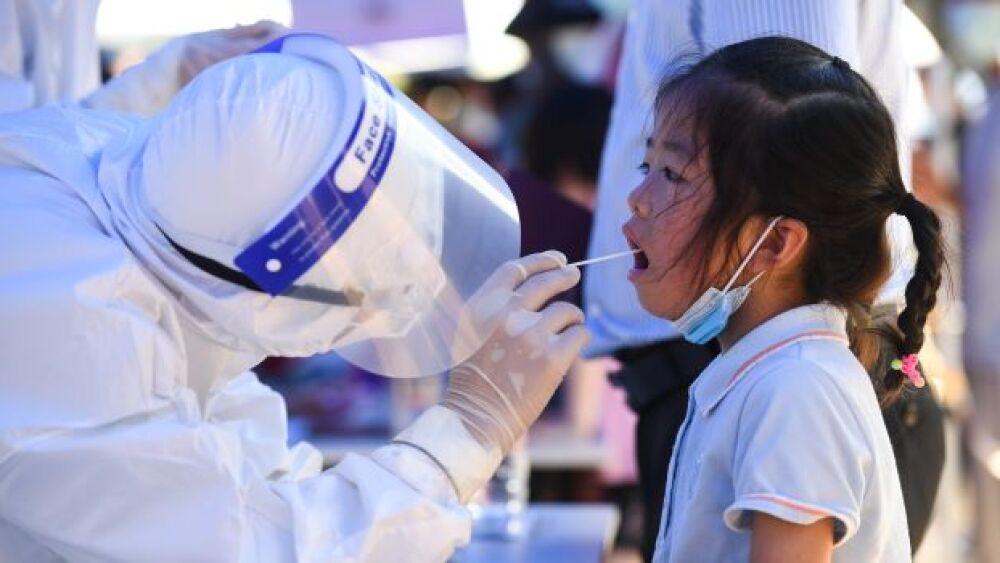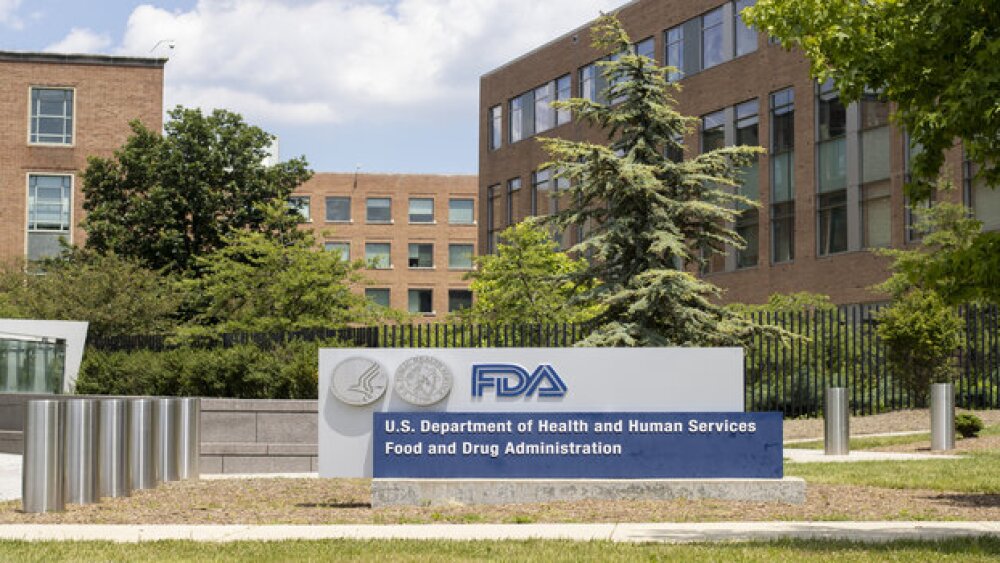There is some evidence that COVID-19 infection might be linked to an increase in diabetes, particularly Type 1 diabetes, which is an autoimmune disease most commonly diagnosed in children.
Covid_Ji Chunpeng/Xinhua via Getty Images
Viral infections can have a broad range of side effects, such as myocarditis, and COVID-19 is no different. But there is evidence that COVID-19 infection might be linked to an increase in diabetes, particularly Type 1 diabetes, an autoimmune disease most commonly diagnosed in children. For that and more, continue reading.
Diabetes Increases COVID-19 Risk But Does COVID-19 Increase Risk of Diabetes?
It’s evident that diabetes and obesity are associated with a greater risk of COVID-19. But there has been some evidence that COVID-19 can lead to diabetes. In some cases, SARS-CoV-2 — as well as other viruses — can attack the islet cells in the pancreas that manufacture insulin. This could trigger at least temporary diabetes in susceptible people. However, increased cases of diabetes may reflect other factors, such as pandemic restrictions, delayed medical care, or unhealthy eating habits and inactivity in people at risk of Type 2 diabetes. In addition, some of the steroids used to treat COVID-19 can cause diabetes; sometimes it resolves, sometimes it doesn’t.
A Centers for Disease Control study of U.S. insurance databases found diabetes was significantly more common in children who had COVID-19. However, the report didn’t separate Type 1 diabetes, an autoimmune disease typically affecting children, and Type 2, which is associated with obesity. The University of Michigan’s Mott Children’s Hospital, for example, has observed a 30% increase in Type 1 diabetes compared to before the pandemic. They haven’t analyzed how many had previous cases of COVID-19, but there is concern that there’s a connection to the dramatic increase.
Rady Children’s Hospital in San Diego reported Type 1 diabetes cases rocketed almost 60% during the first year of the pandemic compared to the previous 12 months. But only 2% had active COVID-19, and the study, which was published in JAMA Pediatrics, did not have information on other types of previous infections. But the jump was alarming and “clearly there’s a lot more work to be done to try to answer why this is happening,” said co-author Dr. Jane Kim.
WHO Expresses Concerns Over Rising COVID-19 Cases
After initial surges from the Omicron BA.1 variant, the pandemic seemed to fade. Still, many parts of the world are seeing another wave, driven in part by another Omicron variant, BA.2, and the relaxing of public health and social measures. Low vaccination rates in some countries are also a factor.
“These increases are occurring despite reductions in testing in some countries, which means the cases we’re seeing are just the tip of the iceberg,” said WHO’s secretary-general Tedros Adhanom Ghebreyesus.
The most significant rises are in the WHO’s Western Pacific region, including South Korea and China, where cases climbed 25% and deaths by 27%. Africa has also seen an increase of 12% in new cases and 14% in fatalities, while Europe reported a 2% increase, but no increase in deaths. It’s not remarkably consistent, though. Denmark saw a brief jump in the first half of February caused by BA.2, which quickly dropped.
“I agree with the easing of restrictions, because you can’t think of it as an emergency after two years,” said Antonella Viola, Ph.D., professor of immunology at Italy’s University of Padua. “We just have to avoid thinking that COVID is no longer there. And therefore, the strictly necessary measures, which are essentially the continuous monitoring and tracking of cases, and the maintenance of the obligation to wear a mask in closed or very crowded places.”
Although the situation currently looks good in the U.S., with cases dropping, some public health experts are nervous that the positive trends might be slowing down. Some wastewater surveillance sites show increased SARS-CoV-2 viral levels, which suggests that cases may climb. However, individual testing is slowing or being done at home, which doesn’t provide public health agencies with a picture of the pandemic.
“We are breathing easier,” said Ezekiel Emanuel, MD, Ph.D., vice provost for global initiatives at the University of Pennsylvania and former member of the Biden transition team’s COVID-19 advisory board. “The mortality rate is coming down, the case rate is coming down, hospitalizations are coming down. But let’s remember, we’ve been here before.”
Young Children Omicron Hospitalizations Increased, with Few Deaths
The CDC reported that during the Omicron surge, young children under the age of five were hospitalized at about five times the previously documented rate during Delta. However, few deaths were reported. Hospitalizations were about six times higher during Omicron for children under six months of age.
The bigger picture here is that COVID can be a severe disease, even in young children and otherwise healthy children,” said William Moss, MD, executive director of the International Vaccine Access Center at the Johns Hopkins Bloomberg School of Public Health. “Although the risk of severe disease is higher in older adults than in children, children are not spared COVID-19, and even otherwise healthy children without underlying health conditions can be hospitalized.”
Predicting a BA.2 Surge
A sister variant of Omicron, BA.2, is rising in parts of the world, including in the U.S. Experts note that if the subvariant does begin to surge in the U.S., people over the age of 65 will be a key indicator of how other variants might affect the population.
“It’s really looking at that older age group and how much prior immunity they have, either from previous infection or vaccination,” said Stephen Kissler, Ph.D., with Harvard’s TH Chan School of Public Health, “that I think has been the best indicator so far of how severe a given number of cases is going to end up being in terms of hospitalizations and deaths.”
Some researchers argue that we’re missing out by focusing on the virus, sampling wastewater and testing people for the virus. The other half of the picture is how the population’s antibodies and T cells adapt, and some researchers suggest we should start a kind of immune surveillance that would inform “when immunity wanes, and when it needs to be augmented,” said John Wherry, PhD, an immunologist at the University of Pennsylvania. It’s not a new idea but testing for antibodies and T cells on a large, population-scale has never been done, likely because it’s much harder to do than testing for viruses. Antibodies are very specific, so one version that is tuned for one variant may not be for the next.
Pfizer-BioNTech Vaccine Safe for People Previously Diagnosed with Myocarditis
The Pfizer-BioNTech and Moderna mRNA vaccines have a very rare association with an inflammatory heart condition called myocarditis. Viral and bacterial infections can also cause myocarditis. A study out of France in 55 patients evaluated whether receiving the Pfizer-BioNTech vaccine was safe for people who had been hospitalized with myocarditis in the last five years. None of the 55 patients, most young men, experienced any side effects from the vaccine. None experienced myocarditis or any other serious adverse event tied to the vaccine. The researchers said one of the reasons they ran the study was because of a patient with a history of previous myocarditis who refused to be vaccinated against COVID-19.
British Regulators Approve AstraZeneca’s Antibody Therapy Against COVID-19
Britain’s Medicines and Healthcare products Regulatory Agency (MHRA) approved AstraZeneca’s Evusheld, an antibody therapy to prevent COVID-19 in adults with poor immune response. They pointed out that about 85% of Britons older than 12 have been vaccinated with two doses, but some immunocompromised people or have a history of severe adverse reactions to vaccines may require an alternative preventative.
“While the COVID-19 vaccines continue to be the first-line defense against COVID-19, we know that some people may not respond adequately to these vaccines,” stated MHRA chief June Raine.
COVID-19 Infections May Cause Chronic Lung Disease Long Term
A study published in Radiology suggests that COVID-19 of any severity may lead to long-term chronic lung disease. Researchers at the University of Iowa evaluated 100 adults who still had COVID-19 symptoms more than 30 days after diagnosis (Long COVID) and then were matched to 106 healthy controls. They analyzed symptoms, pulmonary function tests and CT scans. They describe their findings as small airways disease and suggested lower lung capacity in patients with COVID-19, regardless of severity. They admit they do not know what the long-term consequences are. It appears to be related to either inflammation or fibrosis (scarring).
WHO Likely to Reject Medicago’s COVID-19 Vaccine Over Links to Cigarette Maker
Canadian company Medicago’s COVID-19 is plant-based and leverages GlaxoSmithKline’s pandemic AS03 adjuvant to increase immune response. And it now looks like the WHO may reject the vaccine because of its links to cigarette maker Philip Morris International Inc. Medicago has two shareholders, Mitsubishi Tanaba Pharma Corporation and Philip Morris. The only country to clear the vaccine for use is Canada. But the WHO has specific guidelines about companies with links to the tobacco and firearms industries.
“Due to its connections — it’s partially owned by Philip Morris — the process is put on hold,” said Dr. Mariangelo Simao, WHO’s assistant director-general for drug access, vaccines and pharmaceuticals. “The WHO and the UN have a very strict policy regarding engagement with the tobacco and arms industry, so it’s very likely it won’t be accepted for emergency use listing.”
Soligenix’ COVID-19 Vaccine Shows Promise in Non-Human Primates
Soligenix reported that results of a booster vaccination study of its CiVax COVID-19 vaccine demonstrated rapid improvement of neutralization antibody responses against SARS-CoV-2 and Delta and Omicron variants. CiVax is a heat-stable COVID-19 subunit vaccine. The non-human primates had been doubly vaccinated with an adenovirus vaccine against COVID-19 seven months earlier. Before receiving the booster, neutralizing antibody levels against the original and Delta strains were low but detectable, and undetectable against Omicron. However, a week after the booster, neutralizing antibody levels increased as much as 27-fold against the wildtype Wuhan and Delta strains, and by three weeks up to 243-fold. Levels against Omicron were also rising by the first week after the booster.





